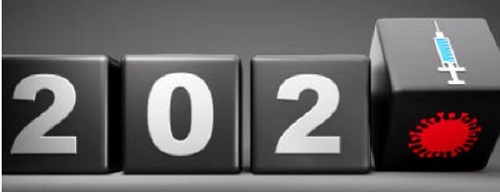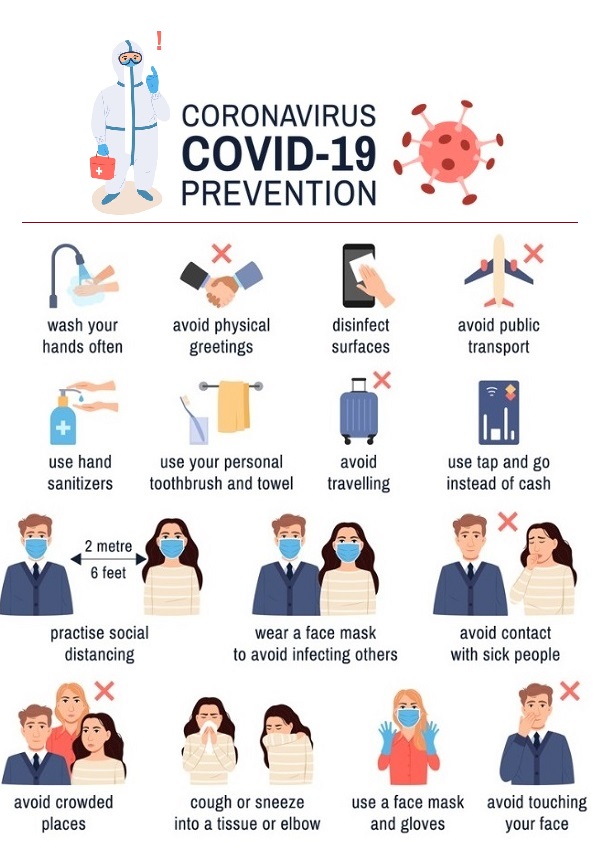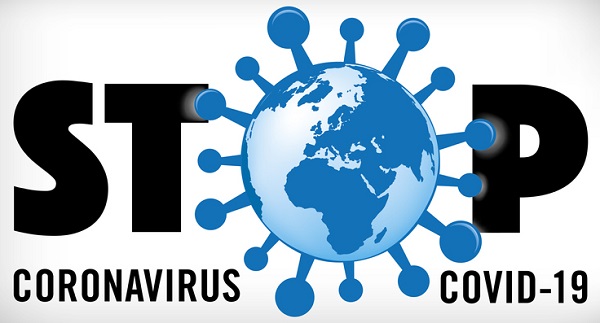Dec 17, 2025
Dec 17, 2025
Although official words have not yet come but the second wave of the Covid-19 pandemic has undoubtedly begun in India amidst the earlier hope and hype that the country had nearly won the battle against the deadly Wuhan coronavirus unleashed on the humanity in the beginning of the year 2020 by some accident or wilful release by the communist country. Such a hope was not without valid reasons because by mid-February 2021 the total number of daily corona positive cases had come down to approximately nine thousand, of which just two Indian states, namely Maharashtra and Kerala, accounted for more than two-third of the daily cases. However, contrary to the trend-based guestimates and a large-scale vaccination programme undertaken, the number of daily reported Covid-19 cases has jumped to over eighty-nine thousand on 2nd April spreading gloom all over the country yet again.

Revisiting Covid-19 Timeline in India
Although so far this pandemic has defeated all human calculations and predictions worldwide but that has neither deterred the scientists and experts to continue with their assessment and forecast nor the zeal and endeavour of the Covid-19 hit countries with the US and India on forefront, to fight to finish the deadly virus. According to reports, the second corona wave may prove more rapid and deadly than the first one; also, the possibility of the third wave cannot be ruled out. Some experts feel that the second wave of Covid-19 cases might peak around mid-April in India and the trend might sustain until the end of May 2021, calling for a more rapid and inclusive vaccination drive to contain the harmful effects of the coronavirus. A brief timeline is given below to appreciate how the pandemic has affected the Indian populace and economy during the last one year and what all has been done in the country to overcome the situation.
Compared to many other nations facing Covid-19 pandemic across the globe, India had to tackle many more challenges due to its sheer size, population and complexities. While the virus equally hit the rich and poor but the latter particularly comprising of small business, street vendors and labour class suffered much more due to stoppage of business activities throughout the lockdown period. At social level too, different communities behaved and conducted differently in response to the restrictions imposed. For instance, a considerably large section of the particular minority community and ignorant people from all sections wilfully defied the government instructions that led to further deterioration of situation and tremendous stress on law enforcing agencies. Consequently, following the lockdown, social life and business was badly hampered forcing the government to initiate unlocking process despite constant increase in the number of Covid patients.
Status of The Vaccination Programme
The long-awaited vaccination programme was launched in India on 16 January 2021 to protect its countrymen against the deadly coronavirus that invaded and shocked the whole world at the beginning of the year 2020. Two vaccines namely Covishield and Covaxin were approved by the Drug Controller General of India (DCGI) for the “emergency use”. Of this, Covishield is one of the frontline vaccines which have been developed by the University of Oxford in UK in collaboration with AstraZeneca, a multinational pharmaceutical company, and is currently under the licenced production at the Pune based Serum Institute of India. Covaxin is the other vaccine which is indigenous in nature both developed and produced by Hyderabad based Bharat Biotech company in collaboration with the ICMR. Both the vaccine candidates have been approved by India’s national drug regulatory body, the Central Drugs Standard Control Organisation (CDSCO); both vaccines can be stored at the normal refrigerator temperature and their low cost makes them suitable for mass production and use in the developing countries.
When the vaccination programme was started in India around mid-January 2021, the number of daily reported fresh cases were on decline except in two Indian states namely Maharashtra and Kerala. On the other hand, this was the time when the US and nearly entire Europe was already gripped under the second coronavirus wave that was proving even more dangerous than the first wave in 2020. Accordingly, some experts had forecasted the possibility of the second wave in India too and that the vaccination drive must be accelerated to cover a significant population of the country. But then it was clear that this virus is not following any predictable trend with the only exception being China from where it had originated and largely contained in Wuhan, Hubei province. The worst fear of scientists and experts have indeed come true as the second wave in India has begun and the daily number has already jumped from about nine thousand in mid-February to over eighty-nine thousand on 2nd April 2021.
Every effort has been made by the concerned agencies in India to augment the production, distribution and use of the two vaccines on the Indian populace. Both vaccines producers had almost simultaneously released their fact sheets and frequently asked questions (FAQs) to satisfy common queries and doubts about the vaccines before use. Such details inter alia included the benefits and possible risks to various categories including those having some medical condition. Perhaps India is the only country which has not only taken care of the vaccination needs of own population but also endeavoured to help its neighbours and other needy countries across all continents. According to tentative estimates, the Indian Government has planned to vaccinate at least about 345 million people. As India is also the home of the world’s vaccine producers with the biggest immunization programmes, the aforesaid feat may appear tough but certainly not beyond the achievable target.
The vaccination drive commenced on 16 January had targeted inoculation of about 30 million doctors, nurses, health workers and other front-line support workers such as police, sanitation and municipal staff in the initial phase. In the next phase, the senior citizens above the age of 60 years and people above the age of 45 years with specific comorbid condition were undertaken with effect from 1st March 2021. Now from 1st April 2021, people of the age of 45 years and above have been made eligible for vaccination. Also, as on this date over 68.8 million vaccine dozes have been administered to the eligible persons and currently the Indian Government has targeted about one-fourth of the total Indian population. Needless to mention, India is the home of the world’s biggest vaccine producers and commensurate immunization programmes, which itself makes it the world’s largest such programme. The only other country with slightly more population is China but no one in this world knows what is actually happening there under the present communist regime.
Indian Vaccines and The World Fraternity
As already mentioned, India is not only the second most populous country but also the largest vaccines producer in the world. While the world’s mightiest country US and other developed and rich nations of the West are largely focused on their own population for the control and safety measures against the ongoing pandemic, India has mobilized its resources not only to protect its own people from the corona menace but also to assist others, particularly the poor and developing countries of Asia, Africa and Latin America that cannot produce Covid-19 vaccines domestically or ill-afford the costly vaccines such as Pfizer and Moderna of the United States or the ones with dubious credentials and cost from the Communist country directly or indirectly responsible for the current nemesis.
The Indian cooperation and assistance to the world community in a joint fight against the coronavirus has been remarkable so far. As per data available upto mid-March 2021, India has supplied approximately 60 million vaccine dozes to other countries world over. Of this, over 8 million dozes have been sent to the friendly countries as gift / free of charge and 16.5 million given as part of Covax mechanism under the aegis of the Global Alliance for Vaccines and Immunisation. The remaining about 35 million dozen have been sent to many other countries on commercial deals including Brazil, Canada, South Africa, Saudi Arabia, Argentina, Mongolia, and so on. So far at least seventy-one countries including the neighbours, except Pakistan, and developing and developed countries have benefitted from the Indian vaccines, and the ministry of external affairs has received similar request from many more countries too.
The vaccine supplies to various countries is likely to continue in a phased manner for a long time. Of the aforesaid 71 countries, at least half of them have received vaccine supplies as gift and cooperation under Covax, or a combination of either of the two and commercial deal. This includes countries in the neighbourhood, Africa, West Asia, Caricom / Caribbean countries, and Pacific Island states. In all, India has supplied vaccines to at least 50% of the Least Developed (LDC) countries and many of the Small Island Developing (SID) countries. The World Health Organization and the United Nations too have also acknowledged and appreciated India’s efforts not only to save own population through the massive vaccination drive but also to help other nations, particularly the aforesaid countries, by supplying them the needed Covid-19 vaccine dozes. More recently, India's donation of vaccines to Afghanistan has been lauded by top UN officials and diplomats from Kabul, which has enabled the war-torn country to undertake a viable vaccination programme at home.
The contrast of the Indian goodwill and cooperation and Chinese opportunism among the world community could be fathomed from a simple illustration. According to the Chinese media claim, China had exported vaccines to twenty-eight countries till early March 2021 and recently they had announced three lakh dozes for Myanmar, the consignment of which is yet to be delivered. As against the aforesaid claim, India has delivered vaccine dozes to seventy-one countries till mid-March that included prompt supply of 1.7 million dozes to Myanmar too. Similarly, Indian vaccines have been delivered to Afghanistan and Cambodia while the Chinese supply to these countries still remains in pipeline.
The Indian Prime Minister talks of the human-centric international cooperation and globalisation. At a time when India is trying to help all other needy countries despite the urgent requirement of vaccinating its own massive population, the developed countries are found mostly focused on own need and greed. According to the Duke University’s Global Health Institute, the developed countries mostly of the West, including US, UK and Canada, with hardly about 16% of world population have secured about 60% of global vaccine supplies for own use. On the other hand, India has extended its helping hands to the big and small countries, the majority of which are poor and underdeveloped. Notwithstanding this a section of Western media cribs that a significant world population is at the mercy of India despite the western governments having spent billions into the research and development of vaccines.
Does Vaccination Prevents Covid-19 Disease?
With the continued vaccination drive in India and worldwide, some fads and misconceptions are also in fast circulation. Many people take vaccine shots with the belief that it will give them complete protection against the Covid-19 disease. Many of them even feel that once they have taken requisite vaccination dozes, they do not need any further precaution or protection, such as observance of social distancing, wearing a facemask, regular handwash, use of sanitiser, and so on so forth. In fact, there have been cases where people are reported coronavirus positive immediately or after few weeks of the vaccination. Such instances confuse ignorant people who then raise doubt or question about the efficacy of the use of vaccines.

To understand this, one needs to know the nature of the vaccine and dynamics of its working. In a nutshell, any vaccine works on the principle of the antigen-antibody reaction or interaction. The novel coronavirus comprises of the RNA core (genetic material) encased under the protein and lipid sheaths. Various vaccines currently under use are based on the inactivated/weakened or genetically engineered virus or RNA core that is not potent enough to cause disease but is able to activate body immune response generating sufficient numbers of antibodies in the host’s body. Thus, vaccination cannot prevent infection of the coronavirus but does produce sufficient antibodies (defence mechanism) in the body of the inoculated person to fight and neutralize it. Therefore, even if the person captures infection, the severity of the disease in such case would be much less with almost no risk of death.
Covid-19 in Global Perspective
Arrival of the multiple vaccine candidates is a silver lining in 2021 for the humanity in the global perspective to deal with the Covid-19 pandemic. Most of the countries across the globe are currently facing the second wave of the coronavirus menace with the developed West being worst hit. After June 2020, the fresh numbers had steadily declined in the US and Western Europe, and India emerged as the epicentres of the pandemic. For most of the July, August and part of September, Europe reported less than 20,000 cases a day, almost a third or fourth of what India alone was then reporting daily. However, a second wave of coronavirus started appearing in both the Western and Eastern Europe in October-November 2020, which was far more serious and deadlier compared to the initial surge.

Ever since this trend has continued in Europe till now with uneven reporting of cases in different countries. During the latter months of the year 2020, the US had experienced a sharp increase in daily number occasionally reaching to 2.50 lakh and above; though the worst phase appears to be over with massive vaccination programme but US is still reporting considerably high numbers on the daily basis. India had shown high surge through the October-November 2020 crossing ten million mark in December. After showing a marked decline in daily numbers till mid-February 2021, a fresh surge of coronavirus positive cases has occurred confirming the second wave of pandemic in India too. The position of five worst affected countries globally along with precursor nation China, is indicated in the following Table.
Table
| S.No. | Country |
T. Cases |
Deaths |
T.Cases 02.04.21 |
Deaths 02.04.21 |
| 1. | US | 13,450,712 | 271,025 | 31,315,968 | 567,610 |
| 2. | Brazil | 6,238,350 | 171,998 | 12,912,379 | 328,366 |
| 3. | India | 9,351,224 | 136,238 | 12,392,260 | 164,141 |
| 4. | France | 2,196,119 | 51.914 | 4,741,759 | 96,280 |
| 5. | Russia | 2,215,533 | 38,558 | 4,572,077 | 100,017 |
| 92. | China | 86,501 | 4,634 | 90,292 | 4,636 |
During the second wave of the pandemic, recently India and Brazil as also Russia and France have swapped their position due to continued high incidence of fresh cases. The second wave in the US and many European countries have been more deadly as can be seen from the total numbers and incidence casualties before and after November 2020. When the virus started spreading fast in the US, the then American President had expressed fears of about one lakh casualties; now total numbers have already crossed three crore with more than five lakh American casualties. The other countries with casualties of one lakh and above are Brazil, India, Russia, UK, Italy and Mexico. In short, the war against the novel coronavirus is still on, multiple vaccine candidates have given new hope but no one really knows how long this war will continue with what cost to nations’ manpower and economy.
Epilogue
A lot has been spoken and written about the novel coronavirus and pandemic caused by it, including the role and opportunism of the communist nation largely responsible for it. The most easily discernible fact is that none of the countries, except China, has been able to tame or defeat this virus so far. In fact, the mighty nations of the developed West, including the US and European Union, have miserably failed to contain this virus so for. On the other hand, if the data shared by China are to be relied upon, the communist country appears to have completely tamed the virus with its initial spread largely contained in Wuhan city, and incidence of only few daily cases thereafter with only two reported deaths during the last 5-6 months. Perhaps it is high time for the Chinese communist regime to prove their good intention, as they often claim so, by sharing their COVID-19 MANTRA with the world community.
The ongoing worldwide vaccination programme of India and other counties is indeed a good development fostering hope in 2021. While India is already giving its best for the wellness of the world fraternity in a joint fight against the deadly virus, the developed and rich nations too must come forward to pool their resources against the pandemic in an endeavour to assist the less resourceful and underdeveloped countries. Currently, developing the herd immunity among the nations appears the only viable option and India has miles to go with only a little over 4 percent population covered so for. While people survived Covid-19 disease would already have certain level of immunity against future infection, the aforesaid herd immunity can be reached by maximizing the vaccination programme. Humanity has survived similar challenges in the past and it is hoped it will survive the present crisis too.
Images (c) istock.com
03-Apr-2021
More by : Dr. Jaipal Singh